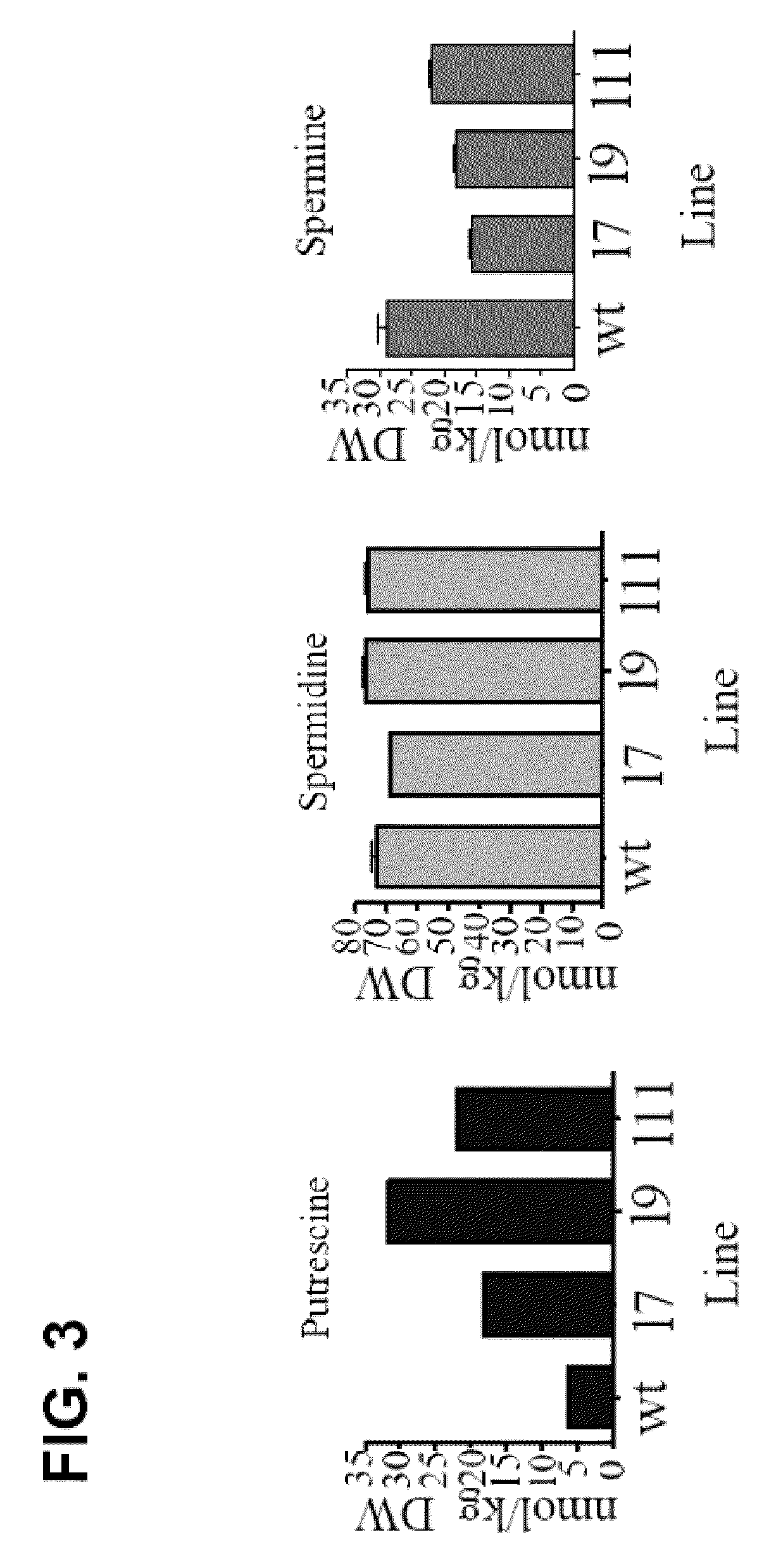Plant having resistance to low-temperature stress and method of production thereof
a plant and low-temperature stress technology, applied in the field of plants having resistance to low-temperature stress and methods of production thereof, can solve the problems of gradual or sudden loss of cell physiological functions, and achieve the effect of increasing productivity and yield
- Summary
- Abstract
- Description
- Claims
- Application Information
AI Technical Summary
Benefits of technology
Problems solved by technology
Method used
Image
Examples
example 1
Obtention of Transgenic Arabidopsis Plants
A. Plasmid Construction
[0048]The Arabidopsis ADC1 cDNA was amplified by PCR from genomic DNA with the following primers: forward 5′-ATGCCTGCTCTAGCTTTTG-3′ (SEQ ID NO: 3), and reverse 5′-ACCGAAATAAGACCAATTC-3′ (SEQ ID NO: 4). The amplified DNA fragment was cloned into pGEM (Stratagene, Heidelberg) and checked by sequencing. The construct containing the ADC1 cDNA, flanked by the cauliflower mosaic virus constitutive promoter (CaMV35S) and the nopaline synthase (NOS) terminator, in a binary vector (pBI121-ADC1) was obtained by replacing the SmaI / SacI GUS gene in pBI121 (cf. Chen et al., “Complete sequence of the binary vector pBI121 and its application in cloning t-DNA insertion from transgenic plants”, Molecular Breeding, 2003, v. 11, p. 289-293; accession number AF485783) with a XbaI / XbaI fragment of ADC1 cDNA (2.6 kb). This construct was introduced into Agrobacterium tumefaciens C58C1 via electroporation and used to transform different plant...
example 2
Obtention of Transgenic Tobacco Plants
[0057]Leaf discs of tobacco plants (Nicotiana tabacum cv. Burley 21) are transformed with Agrobacterium tumefaciens LBA4404 harbouring the construct of interest as described by Horsch et al. (cf. R. B. Horsch et al., “A simple and general method for transferring genes into plants” Science 1985, vol. 227, pp. 1229-1231). The shooting medium contains MS salt mixture (Duchefa, ND), B5 Gamborg vitamins (Duchefa), 1 mg / l benzyladenine (BA, Sigma), 0.1 mg / l naphthalene acetic acid (NAA, Sigma), 50 mg / l kanamycin as antibiotic for the selection of transformed cells and 100 mg / l Claforan to avoid A. tumefaciens growth. After 6-7 weeks in this medium, shoots of the adequate size to be transferred to rooting medium are obtained. Regenerated shoots are excised and transferred to rooting medium: MS with 50 mg / l kanamycin but without hormones (BA, NAA). The kanamycin-resistant plants (3-10 cm hogh) are transferred to compost substrate and grown in the glassh...
example 3
Obtention of Transgenic Tobacco Plants
A. Nicotiana tabacum Transformation
[0060]The pBI121-ADC / plasmid described in example 1 was introduced into Agrobacterium tumefaciens LBA4404 by the freezing transformation method. Agrobacteria were grown at 28° C. with shaking (200 rpm) in YEB broth containing 100 μg / ml streptomycin, 100 μg / ml rifampycin and 50 μg / ml kanamycin. Bacterial suspension of OD600=0.80 was used for transformation. Transgenic tobacco plants (Nicotiana tabacum cv. Xanthi) were generated by the standard leaf disc transformation procedure (cf. Horsch et al. supra). Leaf discs (0.5×0.5 cm2) from sterile tobacco plants were soaked in Agrobacterium containing pBI121-ADC1 construct for 5-10 min with occasional shaking. The Agrobacterium-infected leaf discs were cultivated on MS medium at 25° C. for 2 days and transferred to shooting medium, which contains MS salt mixture (Duchefa, ND), B5 Gamborg vitamins (Duchefa), 1 mg / l benzylaminopurine (BAP, Sigma), 0.1 mg / l naphthalene a...
PUM
| Property | Measurement | Unit |
|---|---|---|
| freezing temperatures | aaaaa | aaaaa |
| temperature | aaaaa | aaaaa |
| temperature | aaaaa | aaaaa |
Abstract
Description
Claims
Application Information
 Login to View More
Login to View More - R&D
- Intellectual Property
- Life Sciences
- Materials
- Tech Scout
- Unparalleled Data Quality
- Higher Quality Content
- 60% Fewer Hallucinations
Browse by: Latest US Patents, China's latest patents, Technical Efficacy Thesaurus, Application Domain, Technology Topic, Popular Technical Reports.
© 2025 PatSnap. All rights reserved.Legal|Privacy policy|Modern Slavery Act Transparency Statement|Sitemap|About US| Contact US: help@patsnap.com



